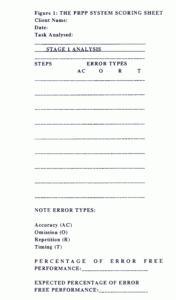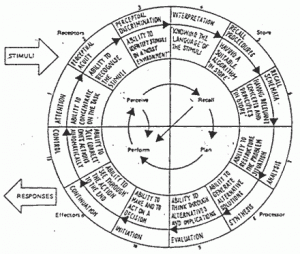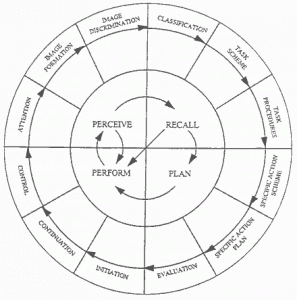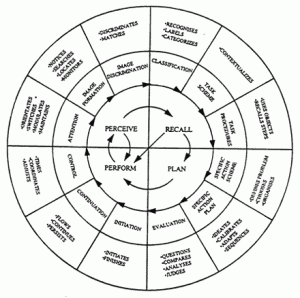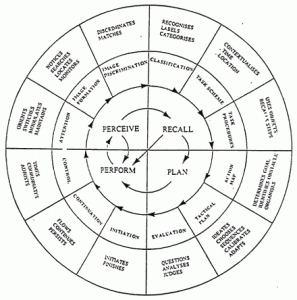Christine Chapparo, Judy Ranka
This paper is adapted from Chapter 9: Research Development. In C.Chapparo and J. Ranka, The PRPP Research Training Manual: Continuing Professional EducationEdition 2.0, (1996)
Christine Chapparo, MA,DipOT,OTR,FAOTA is a senior lecturer in the School of Occupational Therapy, Faculty of Health Sciences, The University of Sydney.
Judy Ranka, BSc, MA, OTR, is a lecturer in the School of Occupational Therapy, Faculty of Health Sciences, The University of Sydney.
DESCRIPTION
The Perceive: Recall: Plan and Perform System (PRPP) is a process-oriented, criterion referenced assessment that employs task analysis methods to determine problems with cognitive information processing component function during routine, task or subtask performance. The PRPP System is for use with adults and children who have difficulty performing daily or episodic tasks. It is suitable for adults and children of either sex and from any cultural background. The time taken to administer the PRPP System varies with the severity of information processing difficulty and the complexity of tasks assessed. A tester familiar with the PRPP System and the client can complete the assessment of one person on four or five tasks in most cases in one to two hours.
The PRPP System is:
- appropriate for adults and children regardless of disabling condition, sex or cultural background
- used by a responsible occupational therapist who knows the client well and who is knowledgable about the effects of information processing disorder on occupational performance
- administered to individual adults or children as they are performing routines or task in an individual or group context
- used in multiple settings where the child or adult performs daily routines and tasks (home, hospital, school, work)
- used to assess routines, tasks and sub tasks that are deemed important by the client or significant others to the client’s occupational role performance
- a comprehensive task analysis of four areas of information processing required for task performance: perception, recall, response planning and performance.
The purpose of this paper is to outline the stages of research that have been carried out to develop the instrument to its present form.
DOMAIN OF CONCERN
The PRPP System is viewed as a tool that can be used by occupational therapists to describe the impact of cognitive component impairment on client performance of occupational roles, routines and tasks (Chapparo & Ranka, 1996), and specifically, information processing. Cognition, has been defined as ‘the individual’s capacity to acquire and use information to adapt to environmental demands’ (Lidz-Schneider, 1987). Occupational therapy focuses on improving occupational performance by integrating component functions. Cognition is conceived as one of the parameters of the profession’s ‘domain of concern’ (Mosey, 1986). Therefore, many occupational therapy conceptual models recognise the importance of cognition to occupational behaviour (Clark, Parham, Carlson, Frank, Jackson, Pierce, Wolfe & Zemke, 1991; Depoy & Burke, 1992; Nelson, 1988). Similarly, the Occupational Performance Model (Australia) (Chapparo & Ranka, 1996), recognises cognition as a major component of occupational performance. The structure of this model suggests a relationship between cognition and occupational performance in everyday functions. Not only is cognition represented in the model as one component of function, it is reflected in the overall definition of occupational performance: “Occupational performance is the ability to perceive, desire, recall, plan and carry out roles ….. for the purpose of self maintenance, productivity, leisure and rest in response to demands of the internal and external environment” (Chapparo & Ranka, 1996.p.4). The PRPP System of Task Analysis was developed out of the expressed need of occupational therapists for an instrument that enabled them to more fully examine the relationship between cognitive information processing and occupational performance.
NEED FOR THE INSTRUMENT
Development of the PRPP System began in 1985 in response to problems that occupational therapy clinicians identified with current methods of assessing cognitive problems in clients with brain injury. Problems centred around four main issues:
- Formal tests of cognition that were available to occupational therapists did not describe real world performance of clients (Tupper & Cicerone, 1988).
- Those tests that were perceived as being ecologically valid were viewed as having limited application for use in the broad practice area of brain injury (Tupper & Cicerone, 1988). Limitations were described in both the number and type of test items and the types of clients that could be tested.
- Therapists felt that the formal test results did little to contribute to planning intervention.
- Most of the formal tests lacked a sound theory base.
Therapists identified a need for a system of assessing cognitive deficits that:
- employed a standard format of administration
- was flexible enough to be used with a wide variety of clients at all levels of function and from different cultural backgrounds
- focussed on the domain of concern of occupational therapy, namely, the impact of cognitive deficits on the performance of client occupational roles and tasks
- was economical in its use of time
- could give guidance for occupational therapy intervention
The PRPP System of task analysis is being developed to meet these needs. Four major phases in development of the PRPP System have been completed to date.
INSTRUMENT DEVELOPMENT
The process of instrument development is a lengthy one that requires continued revision and review. If the final product is to be of use to occupational therapy, it must be reliable, valid and fulfil its main purpose: to enhance the quality of clinical decision making (Opacich, 1991). Benson and Clark (1982) outlined a step by step process through which new occupational therapy instruments can be planned, developed and validated. Four phases are involved in their process of instrument development: planning, construction, quantitative evaluation and validation.
The planning stage described by Benson and Clark (1982), begins with the formulation of statement of purpose of the intended instrument, including a specification of the domain of concern and constructs which are to be measured. The intended target group is also clearly specified. Once the purpose of the instrument is stated, a review of the literature surrounding the area of concern is performed. This aids in formulating the operational definitions of the constructs to be measured. Operational definitions are viewed as being critical to any instrument and must be established at this stage so that the underlying constructs can be linked to the empirical world being observed. When clear operational definitions of observable quantifiable behaviours exist, the instrument can be constructed and examined for reliability and validity. The following outline of instrument development for the PRPP System of Task Analysis shows that the initial planning stage of development has been completed. It has an identified purpose. An underlying conceptual model has been developed (Phase 2 of the research), and all the constructs within the model have been defined (Phase 3). The relevance of the conceptual model to adults and children with brain impairment has been established (Phase 2, 3 and 4), and its relevance to other client populations is currently under study. Preliminary reliability and validity studies have been completed (Phases 1, 2, 3, 4) and a numerical scoring system is undergoing review.
PHASE ONE: (Chapparo and Ranka, 1987 – 1990)
Research Outcome: Development of STAGE 1 analysis of the PRPP System.
25 male (15) and female (10) adults between the ages of 18 and 64 who did not have brain impairment were videotaped performing eating, dressing and meal preparation tasks. Their performances were analysed using a routine behavioural task analysis whereby the task performance was broken down into major motor steps (Brown, 1987). The task steps were then analysed to determine how similar the performance steps were among the 25 adults and to give the researchers some idea about the extent to which individual differences in performance of routine tasks were likely to be viewed as errors in performance. Although there were individual differences in the sequence of some tasks (e.g. sandwich making), there were no identifiable errors.
Test-retest consistency achieved for this analysis on each task among 6 testers ranged above 92%.
20 clients with brain injury who were residing in one of four brain injury units in Sydney were then videotaped performing the same types of tasks. Clients had varying levels of physical and cognitive ability from severe physical limitations and residual posttraumatic amnesia to independent in mobility and oriented to time and place. All clients were identified by their occupational therapists as having some difficulty with cognitive processes that interfered with optimum performance of occupational tasks.
The videotaped performances were analysed using the same task analysis format described above. Errors were catalogued and subjected to content analysis. Four main error types were identified from the analysis.
- Errors of omission (steps omitted)
- Errors of repetition (steps were unnecessarily repeated)Errors of accuracy (steps were inappropriate or wrong, leading to inability to accurately perform the task)
- Errors of timing (the total time taken to complete the task was too long, or too rushed)
Interrater agreement and intrarater consistency in error identification of this part of the analysis was above 90%.
This initial task analysis forms STAGE 1 of the present two stage PRPP System of analysis (Figure 1).
Figure 1: THE PRPP SYSTEM SCORING SHEET
PHASE TWO: (Chapparo and Ranka, 1991-1993)
Research Outcome:
| a. | A system of classifying cognitive errors in performance of occupational tasks. (STAGE 2 ANALYSIS) |
| b. | Identification of a theoretical base for the assessment model, based on information processing theory. |
Development of stage 2 analysis
Although the Stage 1 analysis allowed therapists to identify breakdown in performance of tasks, and to identify the types of errors causing the breakdown in performance, more information was needed to determine the possible reason for errors from a cognitive perspective.
45 adults with brain impairment were videotaped performing dressing, eating, grooming and meal preparation tasks within their hospital environments. Stage 1 analyses were completed, identifying errors in performance relative to omission, repetition, accuracy and timing.
After lists of errors were made, microanalyses were performed on each error. Over 4000 errors were catalogued for analysis. Categorisation of error types relative to the cognitive processes associated with the error fell into four broad error types:
- Errors of perception
Difficulties with attending to the task and perceiving all of its elements
- Errors of recall
Difficulties classifying objects and body parts, remembering how to use them and fitting objects into a functional context
- Errors of planning
Difficulties in planning what to do and how to do tasks, problem solving before and during task performance
- Errors of performance
Difficulty initiating task performance, knowing when to stop or continue performance to its completion
Figure 2: The Expanded Skill Cycle (Romiszowski, 1984.p.124)
Theoretical base
A literature review of the body of knowledge of perception and cognition as it related to brain injury revealed one model of information processing that was congruent with the categorisation of error types. Romiszowski (1984), an instructional psychologist, had developed a model of cognitive requirements for skilled performance of work tasks, which he called the Skill Wheel. He proposed that difficulties in work performance (for example typing) could be explained relative to problems in perceiving, recalling, planning or performing aspects of the task. He further categorised these skill areas into a further 12 subcategories (See Figure 2). Using Romiszowski’s Skill Cycle Model, a further content analysis was completed on each of the four broad error categories to determine if a similar breakdown of error type was possible relative to the performance of the 45 clients with brain impairment.
Client errors were able to be divided into twelve distinct subcategories that were similar but not identical to Romiszowski’s subcategories emerged from this analysis: three in each of the four error types as (See Figure 3).
RELIABILITY AND VALIDITY
To determine the effectiveness and comprehensiveness of the model to identify cognitive errors in task performance, 5 therapists who were considered experienced in the management of adults with brain injury were asked to review 10 of the research tapes. After training to identify behaviours as defined by subcategory constructs, therapists identified errors made by the clients using the total error classification system.
Figure 3:The PRPP System (1993) Quadrants and Subcategories
There was above 85% agreement on placement of errors. All errors were able to be described using one or more of the model subcategories.
The therapists were then asked to rate the system of error identification relative to their satisfaction with its ability to identify and describe cognitive errors in task performance. On a scale of 1 to 10, therapists rated their satisfaction at or above 8.
Romiszowski’s (1984) original model was modified to accommodate the descriptions of errors seen in the performance of 45 adults with brain injury as follows.
PHASE THREE: (Chapparo, Ranka and Osbourne, 1994-1995)
Outcome:
| a. | Further validity studies of the content of the assessment system. |
| b. | A further refinement of error classification by development of ‘descriptors’ (a standard error definition system) for each subcategory of the PRPP System. |
To further enhance the descriptive ability of the PRPP System, the following research was carried out.
VALIDITY STUDY
A further 25 adults and adolescents with brain impairment were videotaped performing eating, drinking, meal preparation and dressing tasks. Stage 1 task analysis was completed to identify errors. Errors were listed and interpreted using the Stage 2 analysis model of the Perceive, Recall, Plan and Perform quadrants, and 12 subcategories (Figure 3). In this second sample, all errors made in performance were again able to be described by using the model, thereby lending support for the validity of the constructs used in the model to describe cognitive performance errors (Osbourne, 1995).
DEVELOPMENT OF DESCRIPTORS
2001 errors were identified in this latest sample of task performances. Transcriptions of the videotaped errors were analysed to determine the key descriptive words used to describe errors made in each of the subcategories.
The list of key words were studied and a final choice of single or paired words, termed ‘descriptors’, that best described subcategory errors were chosen according to five criteria:
- they were ‘doing’ words (See Figure 4)
- they described a cognitive event
- they were observable
- they were everyday words, rather than medical or jargon words
- each word was judged to best reflect the error type
Each descriptor was then operationally defined from three perspectives. First, the Macquarie Dictionary (1990) and Thesaurus (1987) were used to define the essential meaning of each word. Second, the original videotaped performances of adults without brain impairment were used to develop a definition of the descriptor word relative to usual behaviour one would expect to observe during performance of any task. Third, the videotapes of adults and adolescents with brain impairment were used to describe examples of behaviours that would be deemed descriptor errors (See Chapparo & Ranka, 1995; Osbourne, 1995 for detailed definitions). The descriptors were then placed in the appropriate position in the assessment model and the model developed in Phase 2 of instrument was extended (See Figure 4).
Figure 4: The PRPP System Quadrants, Subcategories and Descriptors (Chapparo, Ranka and Osbourne, 1995)
Use of the descriptors was trialed on 60 therapists who work with adults with brain impairment, children with neuromotor disorders, children with learning disorders and adults who required work based training or placement.
Therapists were trained in the use of the PRPP System over a three day period and asked to watch videotaped performances of adults and children doing everyday tasks ranging from eating and dressing to motor proficiency tests and work site job trials. Therapists were asked to give feedback about
| a) | the degree to which the PRPP System, specifically descriptor use, was able to identify errors in performance, and |
| b) | the clarity of definitions of each subcategory and descriptor. |
38 final year occupational therapy students were also trained in the use of the PRPP System and the descriptors over a four-week period. They were then requested to watch two videotapes of one adult with brain impairment and one child with cerebral palsy as they completed hygiene and dressing tasks. Interrater agreement among the 38 students on error identification of each individual descriptor ranged from 95% to 100%. This indicated that:
| a) | with training in the definitions and concepts underlying the PRPP System, therapists can achieve acceptable agreement regarding the observations that are made about client error in performance and, |
| b) | with training in specific methods of observation, therapists with little clinical experience are able to make pertinent observations about information processing errors that interfere with performance of occupational tasks. |
As a result of feedback about the instrument from both therapists and students, the following modifications were made to the 1995 PRPP System Model. Subcategories in the Recall and Plan Quadrants were renamed to better ‘fit’ the nature of errors seen in those aspects of information processing and several descriptor changes were made.
The current training model of the PRPP System is illustrated in Figure 5.
Figure 5: The PRPP System Model (Chapparo & Ranka, 1996)
PHASE FOUR: (Chapparo & Ranka, 1995 – 1996)
The present stage of development is in progress. The objective is to test the effectiveness of the PRPP System of task analysis in identifying information processing deficits in other client populations. Target client populations in this phase of research include children with neuromotor disorders and learning disorders and adults who are ready for work placement. These two client groups were targeted specifically because:
| a) | occupational therapists who intervene with these clients are required to assess various types of functional performance in everyday contexts, and |
| b) | there is no alternative assessment procedure available to determine the impact of information processing difficulty on occupational task performance in these clients. |
FUTURE DIRECTIONS
Currently, therapists, who have received training are using the PRPP System of Task Analysis as a formal task analysis method to identify and describe the impact of cognitive information processing deficits on everyday performance. Reports indicate that the tool has met its original purposes in that it can:
Consistently, enable therapists to identify cognitive deficits that interfere with occupational performance (Osbourne, 1995);
Be used to analyse performance of clients at any level of function (Chapparo & Ranka, 1991, 1992);
Give direct guidance to intervention (Fry & O’Brien, 1997).
Its future use with additional client populations will be determined through additional research.
SUMMARY
Occupational therapy assessment and management of clients with cognitive deficits is in transition in Australia. Traditional practices of assessment involving norm-referenced measures are giving way to new forms of analysing occupational performance. The PRPP System of Task Analysis was developed to meet contemporary needs of therapists to determine the impact of cognitive information processing deficits on everyday occupational performance in real world conditions.
The theoretical model underlying the assessment is based on information processing theory and occupational performance. It assumes that knowing how to generate occupational behaviour at any level is based on a process of a person being able to construct a model of reality that is based on need, choice and interaction with the environment. These individually constructed models occur for each occupational task that is performed and are stored internally as networks of related constructs or schemata of occupational performance. It is these schemata that occupational therapists need to be able to evaluate in depth in order to plan intervention.
The PRPP System involves a two-stage process. First, client task performance is analysed to determine where errors occur in terms of type and sequence. Second, the identified errors are categorised as to whether they are errors of perception, errors of recall, errors of planning or errors of control. To assist the therapist, observations are guided by use of a series of ‘descriptors’, or defined information processing behaviours that are used to identify strengths and weaknesses in task performance. These descriptors are used by the therapist to target processing behaviours that the client needs to learn to successfully complete chosen or needed occupational tasks and routines.
The test, although in its infancy is viewed as a potentially valuable tool for therapists who manage adults and children who have problems with occupational performance due to poor information processing.
REFERENCES
Benson, J., & Clark, F. (1982) A guide for instrument development and validation. American Journal of Occupational Therapy. 36(12) 789-800
Chapparo, C. & Ranka, J. (1996) The Perceive, Recall, Plan and Perform System of Task Analysis. OT Australia, AAOT-NSW, Continuing Education Workshop, Sydney, NSW. February.
Chapparo, C., & Ranka, J. (1992) Development of an information processing task analysis to identify errors in self-maintenance performance of brain injured clients. (Final research report, Category B: Internal). (Available from School of Occupational Therapy, Faculty of Health Sciences, The University of Sydney, East St. Lidcombe. NSW. 2141)
Clark, F.A., Parham, D., Carlson, M.E., Frank, G., Jackson, J., Pierce, D. Wolfe, R.J., & Zemke, R. (1991) Occupational science: Academic innovation in the service of occupational therapy’s future. American Journal of Occupational Therapy, 45, 300-310
DePoy, E. & Burke, J.P. (1992) Viewing cognition through the lens of the model of human occupation. In N.Katz (ed.). Cognitive rehabilitation: Models for intervention in occupational therapy, pp.240-257
Fry, K., & O’Brien, L. (1997) Using the Perceive, Recall, Plan and Perform Model to assess cognitive deficits in a client with traumatic brain impairment. OT Australia, ‘Making a Difference’, 19th National Conference.Perth, Western Australia. May.
Lidz-Schneider, C. (1987) Dynamis assessment. An international approach to evaluation learning potential. New York: Guilford Press
Macquarie Encyclopedic Dictionary (1990) Autralia: The Macquarie library.
Macquarie Thesaurus (1987) Australia: The Macquarie Library.
Mosey, A.C. (1986). Psychosocial components of occupational ttherapy. New York: Raven Press
Nelson, D. (1988). Occupation: form and performance. American Journal of Occupational Therapy, 42, 633-641
Opacich, K. (1991) Assessment and informed decision making. In C. Christiansen & C. Bauma (Eds.). Occupational therapy: overcoming human performance deficits. (pp.355-372) USA:Slack.
Romiszowski, A. (1984) Designing instructional systems. London: Hogan Page
Tupper, D.E., & Cicerone, K.D. (1988) The neuropsychology of everyday tasks:Assessment and basic competencies. Kluwer Academic Publishers.

